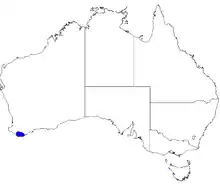Boronia virgata
Boronia virgata is a plant in the citrus family, Rutaceae and is endemic to the south coast of Western Australia. It is a virgate shrub with pinnate leaves with between three and five leaflets, and flowers with red sepals and deep pink, egg-shaped petals.
| Boronia virgata | |
|---|---|
| Scientific classification | |
| Kingdom: | Plantae |
| Clade: | Tracheophytes |
| Clade: | Angiosperms |
| Clade: | Eudicots |
| Clade: | Rosids |
| Order: | Sapindales |
| Family: | Rutaceae |
| Genus: | Boronia |
| Species: | B. virgata |
| Binomial name | |
| Boronia virgata | |
 | |
| Occurrence data from Australasian Virtual Herbarium | |
Description
Boronia virgata is a virgate shrub that typically grows to a height of 1 m (3 ft 3 in) with its branchlets covered with lines of tiny, fine hairs. The leaves are 10–15 mm (0.39–0.59 in) long and have between three and five, rarely seven leaflets that are oblong to elliptical and 3–10 mm (0.12–0.39 in) long. The flowers are borne singly or in groups of three in leaf axils on a thin, glabrous pedicel 6–14 mm (0.24–0.55 in) long. The sepals are very narrow triangular, 2–3 mm (0.079–0.118 in) long red and glabrous. The petals are egg-shaped, deep pink, about 8 mm (0.31 in) long with a minute hairs on the upper surface and the edges of their backs. The stamens are about 3 mm (0.12 in) long with anthers about 1 mm (0.039 in) long. Flowering occurs between August and February.[2][3][4]
Taxonomy and naming
Boronia virgata was first formally described in 1971 by Paul Wilson and the description was published in Nuytsia from specimens he collected near the road between Denmark and Walpole in 1970.[2][5] The specific epithet (virgata) is from the Latin word virgatus meaning "virgate", or "having long, slender but usually stiff twigs".[6]
Distribution and habitat
This boronia grows in open forest in soil that is swampy, or waterlogged in winter, and has been found in near-coastal areas between Walpole and Nornalup.[3][4]
Conservation status
This species of boronia is classified as "Priority Four" by the Government of Western Australia Department of Parks and Wildlife,[3] meaning that is rare or near threatened.[7]
References
- "Boronia virgata". Australian Plant Census. Retrieved 17 March 2019.
- Wilson, Paul G. (1971). "Taxonomic notes on the family Rutaceae, principally of Western Australia". Nuytsia. 1 (2): 203. Retrieved 13 March 2020.
- "Boronia virgata". FloraBase. Western Australian Government Department of Parks and Wildlife.
- Duretto, Marco F.; Wilson, Paul G.; Ladiges, Pauline Y. "Boronia virgata". Australian Biological Resources Study, Department of the Environment and Energy, Canberra. Retrieved 13 March 2020.
- "Boronia virgata". APNI. Retrieved 13 March 2020.
- Francis Aubie Sharr (2019). Western Australian Plant Names and their Meanings. Kardinya, Western Australia: Four Gables Press. p. 336. ISBN 9780958034180.
- "Conservation codes for Western Australian Flora and Fauna" (PDF). Government of Western Australia Department of Parks and Wildlife. Retrieved 13 March 2020.
